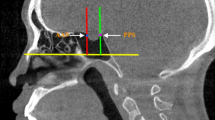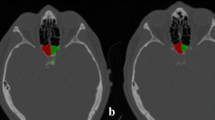Abstract
The purpose of this study was to analyze the volume and area of sphenoid sinuses of Brazilian individuals’ cone-beam computed tomography (CBCT) images using the beta version of the DDS-Pro™ 2.14.2_2022 software (DPP Systems, Czestochowa, Poland), to assess a potential correlation to sex, age, skin color, and nutritional status, and to evaluate differences between the right and left sides. Three-dimensional volume and area measurements were made with the software using CBCT images of 113 living Brazilian individuals of both sexes (67 females and 46 males). TEM, rTEM, and R were used to assess the reproducibility of inter- and intra-examiner measurements. The measurement means were estimated with 95% confidence intervals according to sex and age group. There were no significant differences between the left and right sides for both volume and area and between the sexes and black and white individuals. Volume and area were significantly higher in 18 years or older (p < 0.05) and in individuals with normal body mass index (BMI) (p < 0.05). The obtained results do not allow indicating the use of sphenoid sinuses volume and area measurements to estimate sexual dimorphism, and the same occurred for skin color. However, such measures can help to estimate age. Further studies are suggested with a larger sample, especially for the nutritional status variable.

Source: Own elaboration

Source: Own elaboration




Similar content being viewed by others
References
Slaus M, Strinović D, Pećina-Slaus N, Brkić H, Balicević D, Petrovecki V, Pećina TC. Identification and analysis of human remains recovered from wells from the 1991 War in Croatia. Forensic Sci Int. 2007;171(1):37–43.
Ríos L, Ovejero JIC, Prieto JP. Identification process in mass graves from the Spanish Civil War I. Forensic Sci Int. 2010;199(1–3):e27–36.
O’Donnell C, Iino M, Mansharan K, Leditscke J, Woodford N. Contribution of postmortem multidetector CT scanning to identification of the deceased in a mass disaster: experience gained from the 2009 Victorian bushfires. Forensic Sci Int. 2011;205(1–3):15–28.
Barros F, Fernandes CMS, Kuhnen B, Scarso Filho J, Gonçalves M, Serra MC. Paranasal sinuses and human identification. Res Soc Dev. 2021;10(9):e48710918161.
Garcia CS. Avaliação do seio maxilar no estudo do dimorfismo sexual utilizando imagens por Tomografia Computadorizada de Feixe Cônico [Trabalho de conclusão de curso]. Faculdade de Odontologia de Piracicaba: Universidade Estadual de Campinas. 2014.
Barros F, Serra MC, Kuhnen B, Matos RA, Fernandes CMS. Orthodontic 2D and 3D frontal sinus imaging records: an important role in human identification. Res Soc Dev. 2021;10(13):e49110313608.
Fernandes CMS. Análise das reconstruções faciais forenses digitais caracterizadas utilizando padrões de medidas lineares de tecidos moles da face de brasileiros e estrangeiros [tese de doutorado]. São Paulo: Universidade de São Paulo, Faculdade de Odontologia; 2010.
Berketa JW, James H, Lake AW. Forensic odontology involvement in disaster victim identification. Forensic Sci Med Pathol. 2012;8(2):148–56.
Musse JO. Identificação humana através da análise do seio maxilar em radiografias panorâmicas [tese de doutorado] – São Paulo: Universidade de São Paulo, Faculdade de Odontologia. 2009.
Wen H, Wu W, Fan F, Liao P, Chen H, Zhang Y, Deng Z, Lv W. Human identification performed with skull’s sphenoid sinus based on deep learning. Int J Legal Med. 2022. https://doi.org/10.1007/s00414-021-02761-2.
Cappella A, Gibelli D, Cellina M, Mazzarelli D, Oliva AG, De Angelis D, Sforza C, Cattaneo C. Three-dimensional analysis of sphenoid sinus uniqueness for assessing personal identification: a novel method based on 3D–3D superimposition. Int J Legal Med. 2019;133(6):1895–901.
Fatterpekar GM, Delman BN, Som PM. Imaging the paranasal sinuses: where we are and where we are going. Anat Rec. 2008;291(11):1564–72.
Ritter L, Lutz J, Neugebauer J, Scheer M, Dreiseidler T, Zinser MJ, Rothamel D, Mischkowski RA. Prevalence of pathologic findings in the maxillary sinus in cone-beam computerized tomography. Oral Surg Oral Med Oral Pathol Oral Radiol Endod. 2011;111(5):634–40.
Cagici CA, Cakmak O, Hurcan C, Tercan F. Three-slice computerized tomography for the diagnosis and follow-up of rhinosinusitis. Eur Arch Otorhinolaryngol. 2005;262(9):744–50.
Perini TA, Oliveira GL, Ornellas JS, Oliveira FP. Technical error of measurement in anthropometry. Rev Bras Med Esporte. 2005;11(1):86–90.
R Core Team. R: A language and environment for statistical computing. R Foundation for Statistical Computing, Vienna, Austria. 2021.
Keir J. Why do we have paranasal sinuses? J Laryngol Otol. 2009;123(1):4–8.
Gallup AC, Hack GD. Human paranasal sinuses and selective brain cooling: A ventila- tion system activated by yawning? Med Hypotheses. 2011;77(6):970–3.
Ebrahimnejad H, Zarch SH, Langaroodi AJ. Diagnostic efficacy of digital waters’ and Caldwell’s radiographic views for evaluation of sinonasal area. J Dent (Tehran). 2016;13(5):357–64.
Batista PS, Rosário-Júnior AF, Wichnieski C. Contribuição para o estudo do seio maxilar. Revista Portuguesa de Estomatologia, Medicina Dentária e Cirurgia Maxilofacial. 2011;52(4):235–9.
Gioster-Ramos ML, Silva ECA, Nascimento CR, Fernandes CMS, Serra MC. Human identification techniques in forensic dentistry. Res Soc Dev. 2021;10(3):e20310313200.
Barros F, Serra MC, Kuhnen B, Scarso Filho J, Gonçalves M, Fernandes CMS. Midsagittal and bilateral facial soft tissue thickness: a cone-beam computed tomography assessment of Brazilian living adults. Forensic Imaging. 2021;25:200444.
Simpson E, Henneberg M. Variation in soft-tissue thicknesses on the human face and their relation to craniometric dimensions. Am J Phys Anthropol. 2002;118:121–33.
Fancourt HMS, Stephan CN. Error measurement in craniometrics: the comparative performance of four popular assessment methods using 2000 simulated cranial length datasets (g-op). Foren Sci Int. 2018;285:162–71.
Stephan CN, Preisler R. In vivo facial soft tissue thicknesses of adult Australians. Forensic Sci Int. 2018;282:220e1–22e12.
Stephan CN, Meikle B, Freudenstein N, Taylor R, Claes P. Facial soft tissue thicknesses in craniofacial identification: data collection protocols and associated measurement errors. Foren Sci Int. 2019;304:109965.
Emirzeoglu M, Sahin B, Bilgic S, Celebi M, Uzun A. Volumetric evaluation of the paranasal sinuses in normal subjects using computer tomography images: a stereological study. Auris Nasus Larynx. 2007;34(2):191–5.
Nejaim Y, Farias Gomes A, Valadares CV, Costa ED, Peroni LV, Groppo FC, Haiter-Neto F. Evaluation of volume of the sphenoid sinus according to sex, facial type, skeletal class, and presence of a septum: a cone-beam computed tomographic study. Br J Oral Maxillofac Surg. 2019;57(4):336–40.
Oliveira JM, Alonso MB, de Sousa E, Tucunduva MJ, Fuziy A, Scocate AC, Costa AL. Volumetric study of sphenoid sinuses: anatomical analysis in helical computed tomography. Surg Radiol Anat. 2017;39(4):367–74.
Oliveira JX, Perrella A, Santos KCP, Sales MAO, Cavalcanti MGP. Accuracy assessment of human sphenoidal sinus volume and area measure and its relationship with sexual dimorphism using the 3D-CT. Rev Inst Ciênc Saúde. 2009;27(4):390–3.
Gibelli D, Cellina M, Gibelli S, Oliva AG, Codari M, Termine G, Sforza C. Volumetric assessment of sphenoid sinuses through segmentation on CT scan. Surg Radiol Anat. 2018;40:193–8.
Cohen O, Warman M, Fried M, Shoffel-Havakuk H, Adi M, Halperin D, Lahav Y. Volumetric analysis of the maxillary, sphenoid and frontal sinuses: a comparative computerized tomography based study. Auris Nasus Larynx. 2018;45(1):96–102.
Demiralp KO, Kursun Cakmak S, Aksoy S, Bayrak S, Orhan K, Demir P. Assessment of paranasal sinus parameters according to ancient skulls’ gender and age by using cone-beam computed tomography. Folia Morphol (Warsz). 2019;78(2):344–50.
Koç A. Are maxillary and sphenoid sinus volumes predictors of gender and age? a Cone Beam Computed Tomography study. Cumhur Dent J. 2020;23(4).
Ramos BC, Manzi FR, Vespasiano AI. Volumetric and linear evaluation of the sphenoidal sinus of a Brazilian population, in cone beam computed tomography. J Forensic Leg Med. 2021;77:102097.
Banihashem Rad S, Anbiaee N, Moeini S, Bagherpour A. Sex determination using human sphenoid sinus in a Northeast Iranian population: a discriminant function analysis. J Dent. 2022. https://doi.org/10.30476/dentjods.2022.92915.1685.
Jat BL, Kochar SR, Gupta R, Pathak D, Sharma DK, Gaur K. Volumetric assessment of sphenoid sinus by 3D-CT scan in the age group of 10–22 years: a cross-sectional study. Indian J Forensic Commun Med. 2015;2(3):135–40.
Souadih K, Belaid A, Ben Salem D, Conze PH. Automatic forensic identification using 3D sphenoid sinus segmentation and deep characterization. Med Biol Eng Comput. 2020;58(2):291–306.
Acknowledgements
The authors would like to thank the engineers Tomasz Stefanczyk, MSc, and Tomasz Janikowski, MSc, for their collaboration and technical support on the DDS-Pro® software, and DPP Systems for granting the license to the software aforementioned to perform this study.
Funding
This study was partially financed by the Coordenação de Aperfeiçoamento de Pessoal de Nível Superior—Brasil (CAPES)—Finance Code 001.
Author information
Authors and Affiliations
Corresponding author
Ethics declarations
Ethical approval
This study was approved by the Research Ethics Committee of the School of Dentistry of Araraquara, São Paulo State University (Unesp). (CAAE—nº 47706121.4.0000.5416).
Competing interests
The authors declare no competing interests.
Additional information
Publisher's Note
Springer Nature remains neutral with regard to jurisdictional claims in published maps and institutional affiliations.
Rights and permissions
Springer Nature or its licensor (e.g. a society or other partner) holds exclusive rights to this article under a publishing agreement with the author(s) or other rightsholder(s); author self-archiving of the accepted manuscript version of this article is solely governed by the terms of such publishing agreement and applicable law.
About this article
Cite this article
Barros, F., Serra, M., Kuhnen, B. et al. Sphenoid sinuses’ volume and area analysis of Brazilian individuals’ CBCTs, related to sex, age, skin color, and nutritional status using DDS-Pro™ software. Forensic Sci Med Pathol (2023). https://doi.org/10.1007/s12024-023-00666-7
Accepted:
Published:
DOI: https://doi.org/10.1007/s12024-023-00666-7




